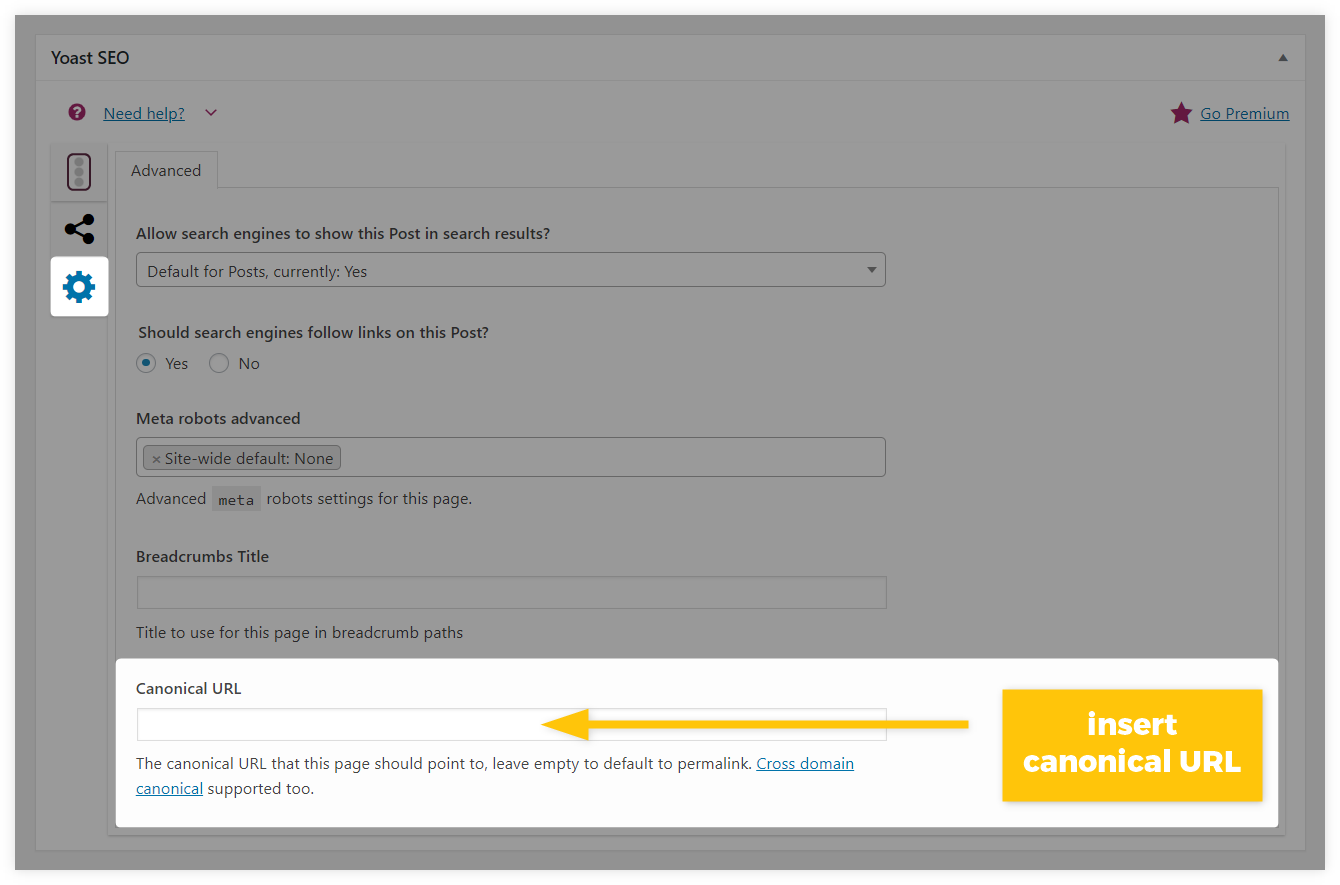What Is Canonical Tag?
A canonical tag (or rel=canonical) is a small piece of HTML code that tells search engines which version of a web page is the “original” one when there are multiple pages with similar or identical content.
In SEO, using canonical tags helps Google to understand which page you want to show in search results. It also combines the ranking power of duplicate pages and helps you to improve how Google crawls and indexes your website.
Canonical Tag – Key Takeaways
- Canonical tags are crucial for addressing duplicate content issues by telling search engines which version of a page should appear in search results.
- These tags combine the PageRank of similar or duplicate pages, improve crawling efficiency, and help in managing syndicated content by pointing to the original source.
- Always use one meta canonical link tag per page, point it to the original version of the content, and avoid self-referencing on paginated pages.
Importance Of Canonical Tags?
Canonical tags are important in SEO because they help you in managing duplicate content issues. When multiple web pages have similar or identical content, search engines may get confused about which one to rank.
By using canonical tags, you tell search engines which version of the page should appear in search results. This helps you to improve your site’s rankings, ensures better indexing, and consolidates link equity from duplicate pages into one main version.
⚙️ Technical & On-Page SEO
- Technical SEO
- On-Page and Off-Page SEO
- On-Page SEO
- How to Optimize Website for SEO Indexing
- Website Speed Optimization Tips
- Keyword Stuffing in SEO
- Rich Snippets
- Internal Linking for SEO
- What is Schema Markup?
- SEO Mistakes
- Pinterest SEO
- SEO Rankings
- YouTube SEO Keywords
- How to Do Keyword Research
- Keywords in SEO
- SEO Meta Title and Description
- Meta Title Tag
- Meta Tags for SEO
- Meta Title
- Meta Description
- SEO Meta in 1 Click
- Alt Tag (Image)
- Canonical Tag
- H1 Tag
Example Of Canonical Tag
A real-life example of using canonical tags is when an e-commerce website has different URLs for the same product due to filters or sorting options. For example, a product may appear at:
| Example Of Canonical Tag |
| www.example.com/product/shoes?color=red
www.example.com/product/shoes?sort=price |
Although the product is the same, these URLs are different. A canonical tag can be used to point search engines to the main version, like www.example.com/product/shoes, so only this URL is prioritized in search results. This will help you to avoid duplicate content issues and will help you to ranking power.
SEO Benefits Of Canonical Tag
Using Canonical tags has many important benefits and advantages. Some of the common SEO benefits of Canonical link tag are given below for your reference:
1. They Combine The PageRank
Canonical link tags help you to combine the ranking power of multiple pages with similar content into one primary page. When duplicate or similar pages exist, search engines may distribute ranking power across them, which cause in the weakening of the overall PageRank.
By using a canonical tag, you will tell search engines to treat one page as the main version, combining the link equity and improving the ranking of that primary page in search results.
2. They Help Manage Syndicated Content
For websites that share content across different platforms or sites, canonical tags are essential. They allow you to point to the original source of the content, helping search engines understand where the main version lives.
This prevents issues where duplicate versions of the same content appear across the web and ensures that the original source receives the credit in search rankings.
3. They Improve Crawling
Search engines like Google have limited resources to crawl and index websites. Canonical link tags help by directing the crawlers to focus on the main version of a page instead of wasting time on duplicates.
This means search engines can use their resources more efficiently to crawl the most important pages, which can improve your website’s overall indexing and visibility in search results.
How To Add A Canonical Tag?
Adding canonical link tags to your web pages is quite simple. If you have a duplicate page, just place the rel=”canonical” tag in the <head> section of the page. This tag should automatically link the page to the original version of the page.
Though it is best to add canonical tags on one page at a time but this can be time-consuming and difficult for larger websites.
So, to solve this problem, there are tools that can do this automatically. For WordPress users, plugins like Yoast SEO can help you with adding canonical tags. With Yoast SEO, setting up canonical tags is easy and can save you a lot of time. Just install the plugin and follow the steps to let it handle the tags for you.
- Choose the page on which you want to apply the canonical tag.
- Go to the “Advanced” section of the page
- Add the canonical URL that you want to refer to as a main page.

Canonical Tag Best Practices
1. Use One Tag per Page
Every page on your site should have only one canonicalization tag. This canonicalization tag helps search engines to understand which URL to index and show in search results.
Adding multiple Canonicalization tags on a single page can confuse search engines, leading to poor SEO results. Always include one clear canonical tag in the `<head>` section.
2. Point to the Main Version
The canonicalization tag should always point to the original or main version of the content. If you have multiple pages with similar or identical content, use the canonical link tag to indicate which version you want search engines to index. This prevents issues with duplicate content and ensures that search engines focus on the preferred page.
3. Avoid Using Self-Referencing Canonical Tags on Paginated Pages
For content that spans multiple pages, avoid using a canonical tag that points all pages to the first page. Instead, let each page in the series have its own canonical tag.
If you point all pages to the first one, search engines may ignore the rest, and users won’t find the other important content in search results.
4. Ensure Consistency
Consistency is the key in canonical link tag implementation. If similar pages exist across different sections of your website, ensure that the canonical tags point to the same canonical link URL every time.
Inconsistencies can cause confusion for search engines, resulting in lower rankings or misinterpretation of your content.
5. Watch for Case Sensitivity
Canonical link URLs are case-sensitive, meaning that “example.com/Page” and “example.com/page” are considered two different URLs.
Make sure the URL in your canonical link tag matches the actual URL perfectly, including case sensitivity. Even a small difference could cause search engines to treat the URL as separate from the original page.
6. Test After Implementation
After you’ve added canonical link tags, it is important to test them. Use tools like Google Search Console to check if the canonical tags are implemented correctly.
These tools can help you identify any issues, such as improper tagging or potential duplicate content, so you can fix them quickly and avoid SEO problems.
Learn Digital Marketing With PW Skills
Are you looking to start your journey in digital marketing, but confused with plenty of courses available online? Don’t worry we got you covered!
Join our Comprehensive PW Skills Digital Marketing with AI Course to learn different strategies for digital marketing with the power of Artificial Intelligence. The course is specially designed by experts for beginners, freshers, or working professionals who want to start their careers as digital marketing experts.
This course comes with plenty of benefits that will help you become a digital marketing expert with more than 125+ hours of learning materials taught by industry experts, covering all the in-demand topics, regular doubt-clearing sessions, Daily practice sheets, interview preparation by experts, 100% job assistance and much more only at pwskills.com
Recommended Course
Canonical Tag FAQs
Why are canonical tags important?
Canonical tags are important because they help search engines understand which version of a page should be indexed. This prevents confusion over duplicate content and helps maintain a clear ranking for the original content.
How do I implement a canonical tag?
To implement a canonical tag, add the following code in the section of your webpage: .
Can I use canonical tags on different domains?
Yes, you can use canonical tags to point to a page on a different domain. This can be useful for indicating the preferred version of content that exists on multiple sites.

